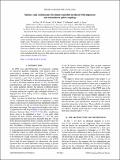Files in this item
Surface code architecture for donors and dots in silicon with imprecise and nonuniform qubit couplings
Item metadata
| dc.contributor.author | Pica, Giuseppe | |
| dc.contributor.author | Lovett, Brendon William | |
| dc.contributor.author | Bhatt, R. N. | |
| dc.contributor.author | Schenkel, T. | |
| dc.contributor.author | Lyon, S. A. | |
| dc.date.accessioned | 2016-02-11T10:40:05Z | |
| dc.date.available | 2016-02-11T10:40:05Z | |
| dc.date.issued | 2016-01-14 | |
| dc.identifier | 240790645 | |
| dc.identifier | e24775a1-bba0-427c-8930-0d91873b7f80 | |
| dc.identifier | 84955243076 | |
| dc.identifier | 000368295600001 | |
| dc.identifier.citation | Pica , G , Lovett , B W , Bhatt , R N , Schenkel , T & Lyon , S A 2016 , ' Surface code architecture for donors and dots in silicon with imprecise and nonuniform qubit couplings ' , Physical Review. B, Condensed matter and materials physics , vol. 93 , no. 3 , 035306 . https://doi.org/10.1103/PhysRevB.93.035306 | en |
| dc.identifier.issn | 1098-0121 | |
| dc.identifier.other | ORCID: /0000-0001-5142-9585/work/47136564 | |
| dc.identifier.uri | https://hdl.handle.net/10023/8197 | |
| dc.description | This research was funded by the joint EPSRC (EP/I035536)/ NSF (DMR-1107606) Materials World Network grant (GP, BWL, SAL), the EPSRC grant EP/K025562 (BWL), the NSF MRSEC grant DMR-01420541 (SAL), and the Department of Energy, Office of Basic Energy Sciences grant DE-SC0002140 (RNB) and the DOE Office of Science under Contract No. DE-AC02-05CH11231 (TS). G.P. thanks the University of St. Andrews and EPSRC for a Doctoral Prize Fellowship. | en |
| dc.description.abstract | A scaled quantum computer with donor spins in silicon would benefit from a viable semiconductor framework and a strong inherent decoupling of the qubits from the noisy environment. Coupling neighboring spins via the natural exchange interaction according to current designs requires gate control structures with extremely small length scales. We present a silicon architecture where bismuth donors with long coherence times are coupled to electrons that can shuttle between adjacent quantum dots, thus relaxing the pitch requirements and allowing space between donors for classical control devices. An adiabatic SWAP operation within each donor/dot pair solves the scalability issues intrinsic to exchange-based two-qubit gates, as it does not rely on subnanometer precision in donor placement and is robust against noise in the control fields. We use this SWAP together with well established global microwave Rabi pulses and parallel electron shuttling to construct a surface code that needs minimal, feasible local control. | |
| dc.format.extent | 1253378 | |
| dc.language.iso | eng | |
| dc.relation.ispartof | Physical Review. B, Condensed matter and materials physics | en |
| dc.subject | QC Physics | en |
| dc.subject | TK Electrical engineering. Electronics Nuclear engineering | en |
| dc.subject | Electronic, Optical and Magnetic Materials | en |
| dc.subject | Condensed Matter Physics | en |
| dc.subject | NDAS | en |
| dc.subject | BDC | en |
| dc.subject.lcc | QC | en |
| dc.subject.lcc | TK | en |
| dc.title | Surface code architecture for donors and dots in silicon with imprecise and nonuniform qubit couplings | en |
| dc.type | Journal article | en |
| dc.contributor.sponsor | EPSRC | en |
| dc.contributor.sponsor | EPSRC | en |
| dc.contributor.institution | University of St Andrews. School of Physics and Astronomy | en |
| dc.contributor.institution | University of St Andrews. Condensed Matter Physics | en |
| dc.identifier.doi | 10.1103/PhysRevB.93.035306 | |
| dc.description.status | Peer reviewed | en |
| dc.identifier.grantnumber | EP/I035536/1 | en |
| dc.identifier.grantnumber | en |
This item appears in the following Collection(s)
Items in the St Andrews Research Repository are protected by copyright, with all rights reserved, unless otherwise indicated.

